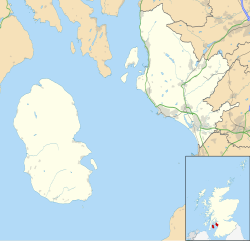Portencross
| |
|---|---|
 Portencross viewed from its pier | |
Location within North Ayrshire | |
| OS grid reference | NS176489 |
| Council area | |
| Lieutenancy area | |
| Country | Scotland |
| Sovereign state | United Kingdom |
| Post town | WEST KILBRIDE |
| Postcode district | KA23 |
| Dialling code | 01294 |
| Police | Scotland |
| Fire | Scottish |
| Ambulance | Scottish |
| UK Parliament | |
| Scottish Parliament | |
Portencross (Scottish Gaelic : Port na Crois) is a hamlet near Farland Head in North Ayrshire, Scotland. Situated about three kilometres (two miles) west of Seamill and about two kilometres (1+1⁄4 miles) south of Hunterston B nuclear power station, it is noted for Portencross Castle.
Contents
It has two harbours and a pier. The "Old Harbour" is actually a small tidal inlet next to the castle, and is part of the castle property. The larger harbour, "North Harbour", owned by the Portencross Harbour Trust, lies about 100 m (110 yd) north of the castle and was the main access point for fishing activity. [1]
The Portencross Pier was built in the era of Clyde steamer cruising but was never used as much as other locations such as Largs, Fairlie or Wemyss Bay.
